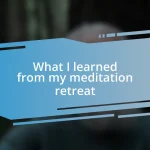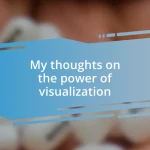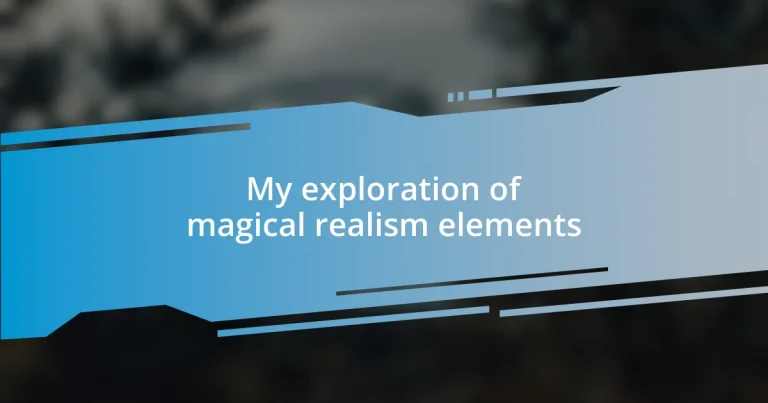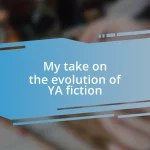Key takeaways:
- Magical realism blends the ordinary with the extraordinary, allowing readers to explore deeper emotional and cultural connections through fantastical narratives.
- Rooted in Latin American literature, the genre emerged in the mid-20th century, reflecting social issues and historical contexts while gaining global recognition through authors like Gabriel Garcia Marquez and Isabel Allende.
- Techniques such as layering narratives and blending realities not only enhance storytelling but also provide therapeutic applications, fostering creativity and personal growth across various fields.
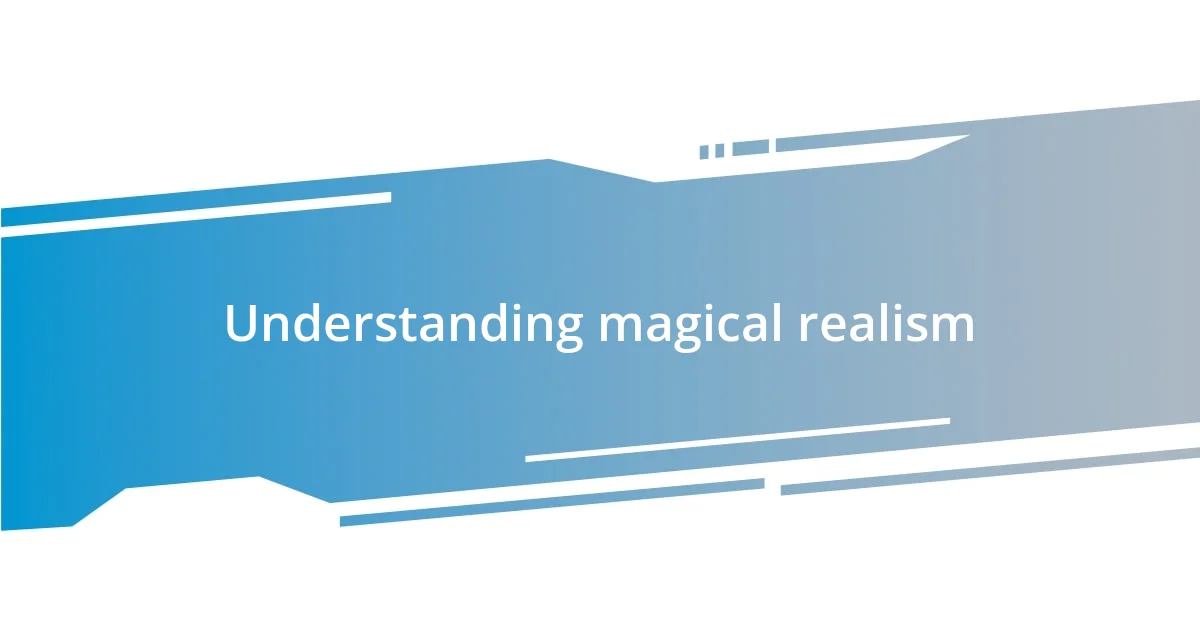
Understanding magical realism
Magical realism is a beautiful blend of the ordinary and the extraordinary, where fantastical elements exist in a realistic setting. I remember reading Gabriel Garcia Marquez’s One Hundred Years of Solitude and feeling as if the world he crafted was just a step away from my own. Can’t you just imagine living in a place where rain is made of flowers and ghosts inhabit everyday life? That’s the magic of it: it makes you question the boundaries of reality.
This genre invites us to explore our emotions and experiences in a way that feels deeply personal. For instance, in my own life, there have been moments that blurred the line between what feels real and what feels like a dream, especially during times of intense emotion. Isn’t it fascinating how those experiences can make us feel like we’re part of a larger, woven tapestry of magic? This aspect of magical realism resonates with readers, enabling them to engage with their inner worlds more profoundly.
At its core, magical realism serves as a lens through which we can examine social issues and cultural contexts. I often find myself reflecting on the historical and personal narratives embedded within these fantastical stories. Have you ever noticed how the characters’ realities mirror our struggles? It’s as if the magical elements help us process our feelings, provoking thought and prompting deeper understanding of ourselves and our surroundings.
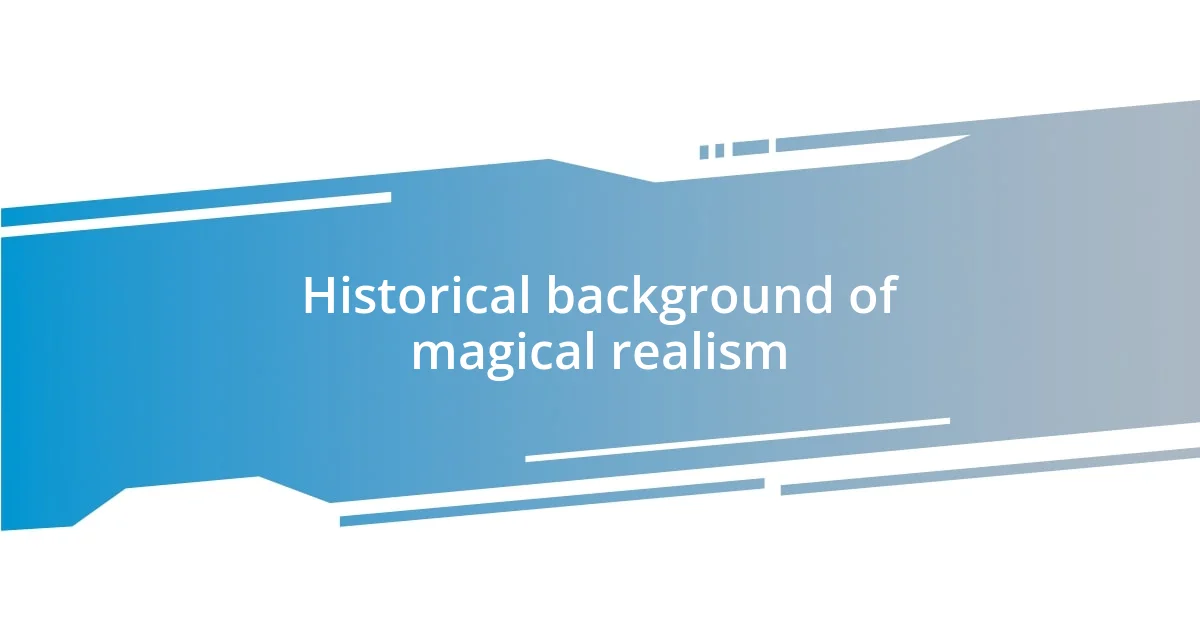
Historical background of magical realism
Magical realism has its roots in Latin American literature, emerging in the mid-20th century. I recall the first time I stumbled upon this genre; it transported me to worlds filled with vibrant colors and surreal occurrences, instilling in me a sense of wonder. The influence of historical events, such as colonialism and political unrest, shaped the narratives, allowing writers to blend the magical with the real to comment on societal issues subtly.
Additionally, the rise of magical realism coincided with the Latin American Boom, a literary movement where authors like Gabriel Garcia Marquez and Julio Cortázar gained global recognition. I often reflect on how their unique storytelling styles influenced my perspective on fiction. It’s intriguing to think about how these writers used allegory and metaphor to address their experiences, creating a space where reality and fantasy coexist, enriching the narrative with layers of meaning.
As I delve deeper into this genre’s background, it’s clear that magical realism transcends mere storytelling. It embodies cultural identity and memory, illustrating how communal histories shape individual experiences. Have you ever felt as if you were part of a larger narrative? That’s what these works evoke—a sense of connection to something greater, resonating with my own longing to understand the intricate tapestry of life.
| Key Elements | Historical Context |
|---|---|
| Latin American Origins | Mid-20th Century Development |
| Influence of Colonial History | Reflection of Social Issues |
| Literary Boom Era | Global Recognition of Authors |
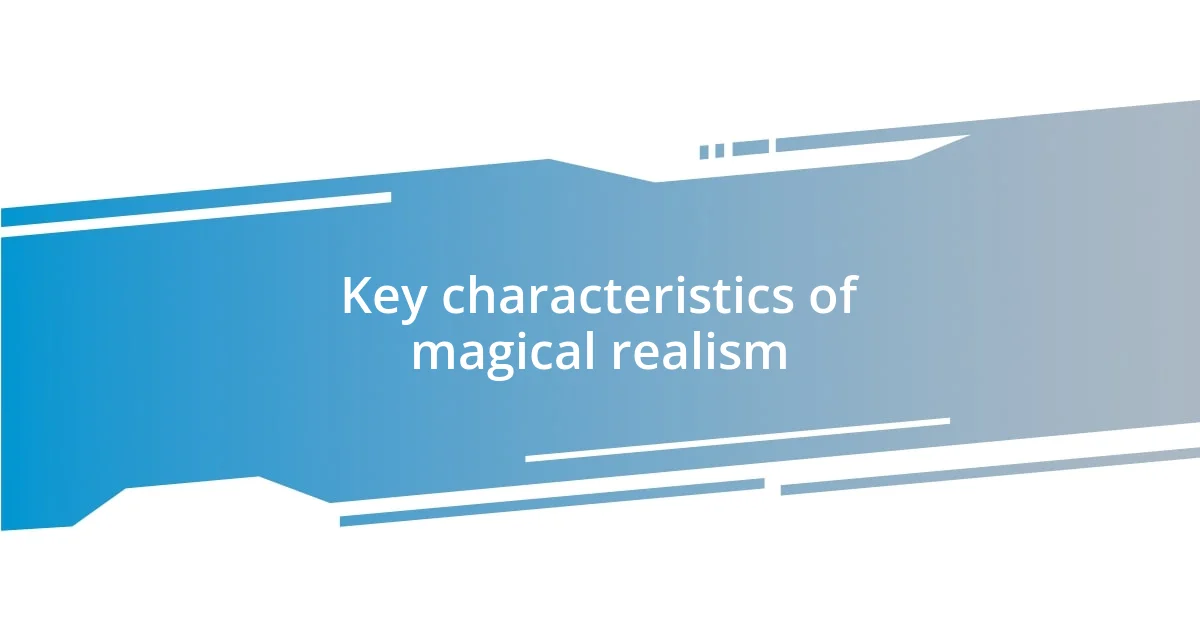
Key characteristics of magical realism
Magical realism draws readers in with its seamless integration of fantastical elements into everyday life. One characteristic that stands out to me is the ordinary coexistence of the extraordinary. For instance, I recall a phrase that stuck with me: “the mundane was often partnered with the miraculous.” This perspective challenges our preconceived notions of reality. When I first encountered magical realism, it felt as though a veil had been lifted, allowing me to see the magic hidden in my own daily experiences, whether it was an unexpected moment of serendipity or a simple walk through a neighborhood rich with stories.
Here are some key characteristics that define magical realism:
- Blending of reality and fantasy: Ordinary settings serve as backdrops for magical elements, challenging the reader’s perception of what is real.
- Subtlety of magical occurrences: It’s not about grand spectacles; small wonders evoke a sense of curiosity and wonder in daily life.
- Rich cultural context: The stories often reflect the traditions and beliefs of the culture they originate from, adding depth and meaning.
- Complex characters: Protagonists often face personal and societal struggles, making their experiences relatable amid the enchanting backdrop.
- Emotional resonance: Magical realism engages readers by evoking strong feelings, encouraging them to reflect on their lives and experiences.
I often find myself reflecting on how these elements resonate not just in literature, but in my own reality. How often do we overlook the extraordinary in our mundane routines? Through magical realism, we’re reminded to open our eyes to the possibilities that exist just beneath the surface of our everyday lives.
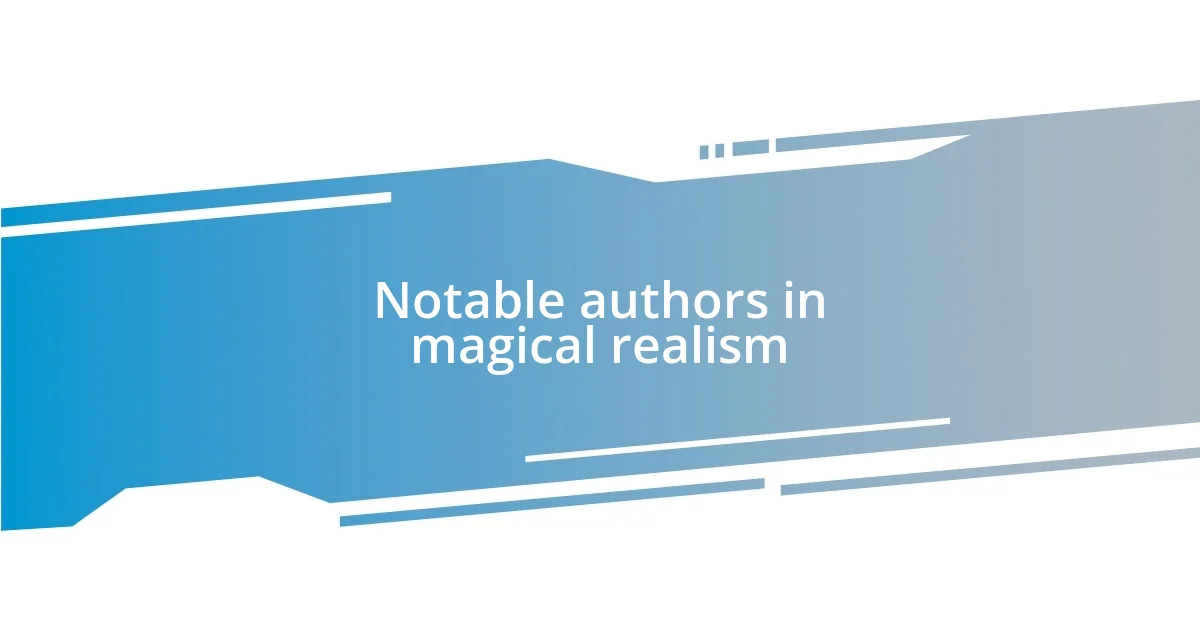
Notable authors in magical realism
Some of the most notable authors in magical realism include Gabriel Garcia Marquez, whose masterpiece “One Hundred Years of Solitude” encapsulates the genre’s essence with its multi-generational saga filled with enchanting occurrences. I remember being completely absorbed by the Buendía family’s story, feeling as though I were a part of their magical world. It made me question how our family histories intertwine with the fantastical elements of our lives, a reflection that lingers with me even today.
Another significant figure is Isabel Allende, who brings her Chilean roots into her narratives, weaving together personal and political themes. In “The House of the Spirits,” I found myself captivated by the blend of the supernatural and the everyday, particularly how each character’s journey reflected broader societal changes. It struck me how Allende masterfully uses these magical elements to highlight the resilience of the human spirit, making her work not just a story but an emotional exploration of identity and memory.
Then there’s Jorge Luis Borges, whose short stories often blur the lines of reality and fiction. His exploration of infinite realities and parallel worlds left me pondering the nature of existence itself. Have you ever thought about how narratives shape our understanding of life? Borges’ work made me realize that storytelling is not just an escape; it’s a profound examination of our own realities, inviting us to rethink our perspectives within the magical fabric of life.
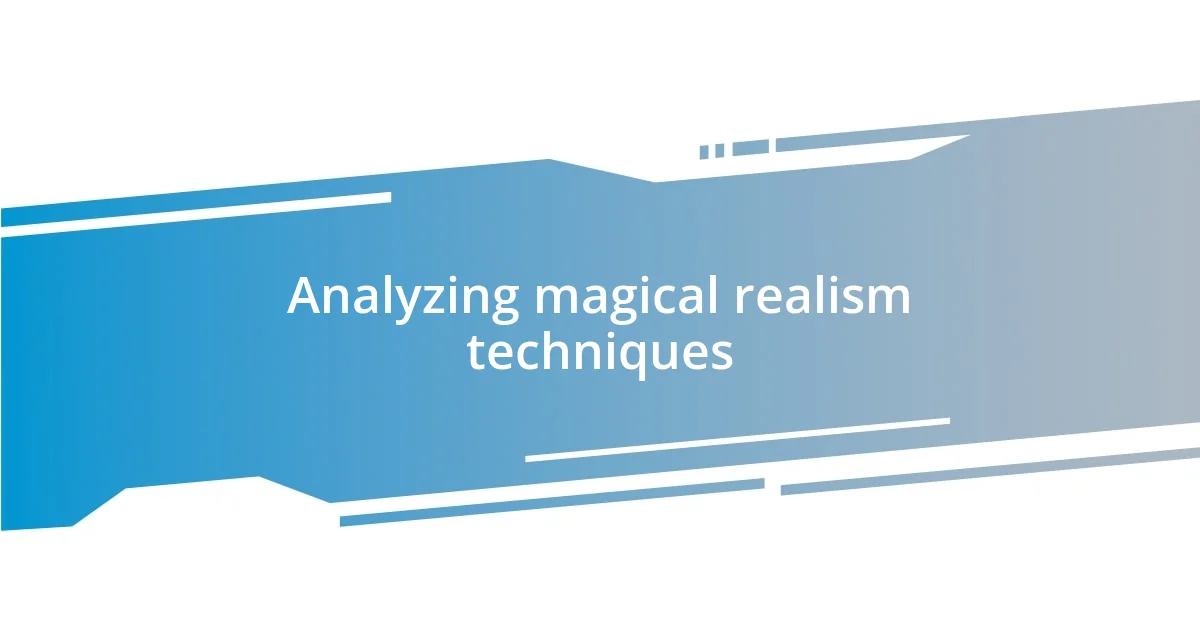
Analyzing magical realism techniques
When analyzing the techniques of magical realism, I often find myself drawn to the subtle weaving of extraordinary experiences into the fabric of everyday life. This technique allows readers to experience the magic without even realizing they’re being transported into a different realm. I remember reading a story where a character’s dreams would manifest as physical objects. It felt so relatable, as if my own dreams could suddenly become tangible. Doesn’t that make you wonder about the hidden potential in our imaginations?
Another fascinating technique is the use of layered narratives, where the point of view may shift and merge realities. This approach creates a rich tapestry of meaning that often reflects cultural and historical contexts. I recall a moment from one book where the protagonist’s memories bled into current events, making me question the line between past and present. Have you ever had a memory that felt so vivid it almost seemed to alter your current reality? That blurring of timelines can be such a powerful way to connect with the reader’s own experiences.
Lastly, the emotional depth in magical realism often stems from the complexities of its characters. I’ve encountered protagonists who grapple with their identity in a world that feels both magical and oppressive. Their struggles resonate with my own experiences, revealing the universal quest for belonging. Why do I think this connection stands out? It’s because the magic mirrors our human emotions, transforming everyday challenges into extraordinary journeys. Isn’t it fascinating how fiction can help us process our lives in a much deeper way?
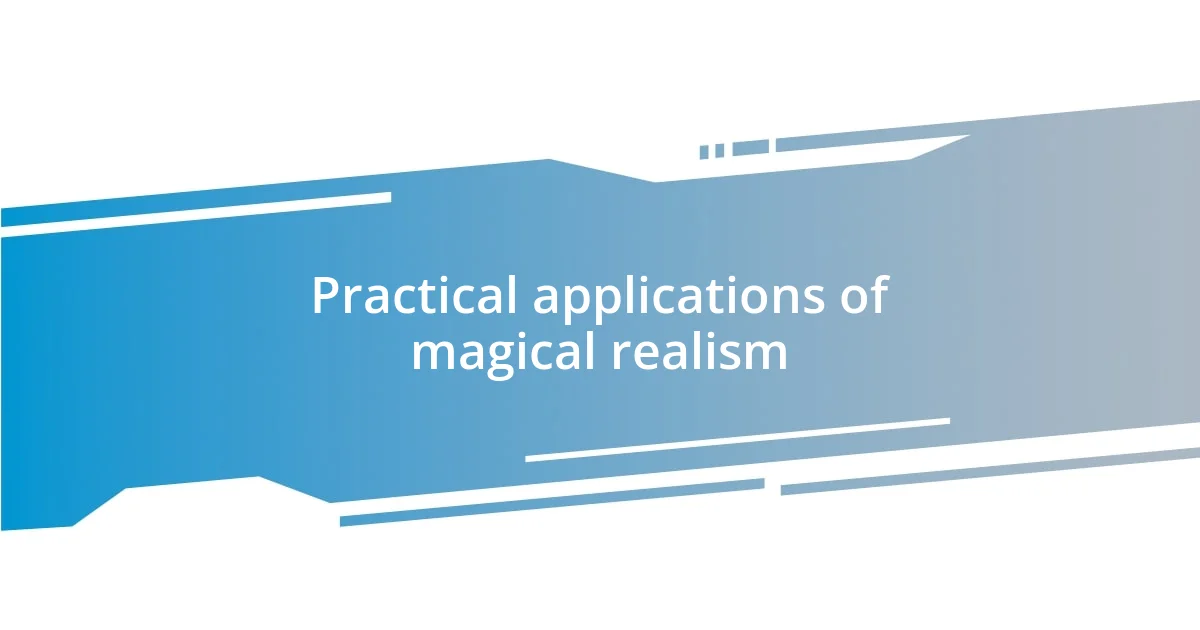
Practical applications of magical realism
Integrating magical realism into various fields can offer unique perspectives and solutions. For instance, in education, I’ve seen teachers use stories rich in magical realism to spark students’ creativity. This can transform traditional lessons into immersive experiences, making lessons memorable and stimulating. When I shared a magical realism piece with my students, their imaginations lit up, revealing how these fantastical narratives can foster engagement and critical thinking.
In visual arts, the essence of magical realism can transcend mere representation. During my own artistic explorations, I’ve combined surreal imagery with everyday scenes to evoke emotion and provoke thought. This not only captivates the viewer but also invites them to explore their subconscious. Have you ever looked at a painting that felt as though it told a story? That’s the power of blending the ordinary with the extraordinary, leading the audience to discover meaning beyond what meets the eye.
Magical realism also finds its way into therapy and personal development. I once participated in a workshop where we used storytelling to unlock emotions and confront fears. By framing personal experiences within a magical context, I felt a shift in how I viewed my challenges. This technique encouraged a playful yet profound exploration of self, guiding participants to reconcile their realities with the fantastical solutions they imagined. Does this make you consider how storytelling might empower you in your life?
